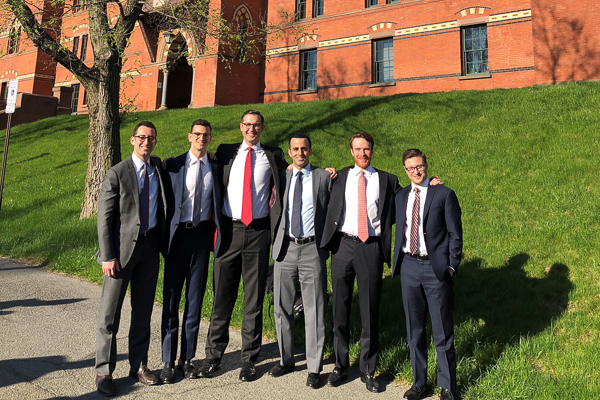“Pitch me a deal” week: Time to tell our own story

By Daniel Kaufman, Two-Year MBA ‘19
Looking at the final two Investment Banking Immersion (IBI) cases, the cohort knew that the hardest assignments were yet to come. There would be less guidance from Drew Pascarella, senior lecturer of finance, and no guidance on topics to cover, diligence materials to read, and financial assumptions to use. From here on out, we were on our own.
The one piece of guidance that Pascarella did provide was to pitch a potential transaction relevant to the group you would be joining for your summer internship. My case team was mainly composed of classmates going into industrials and leveraged finance groups, so we decided it’d be best to combine the two. As we gathered in Sage Hall to get started, we looked at each other and asked: “Who are we going to conduct a leveraged buyout (LBO) on?”
Company selection for a leveraged buyout
One Johnson’s greatest assets is its Management Library, which offers students access to some of the world’s most important business publications, journals, and databases. As we set out on our search, we knew we had resources to draw from. We discussed some high-level characteristics that our company would need to possess:
- Size: We needed a company that was big, but not too big. The transaction enterprise valuable had to be realistic for a typical financial sponsor.
- Valuation: We wanted our sponsor-client to avoid chasing an overvalued asset. We looked for a company that traded at a slight discount to peers.
- Growth potential and margin expansion: Simply put, sales growth and margin improvements drive returns.
We zeroed in on two companies: Apogee Enterprises, Inc. (architectural glass and framings systems) and Timken Company (bearings). We chose Apogee because of its slightly smaller size, cheaper valuation, and superior growth and margin potential. With our target selected, it was time to do some reading.
Reading materials and diligence period
Given that I would likely have to conduct company-related due diligence during my internship, I took responsibility for the Apogee-specific research. I was excited to learn about the company, but then it dawned on me that I was going to come up to speed rather quickly. With a weekend class on the horizon, I had about two days to learn as much as possible.
After combing through the company’s latest 10-K, I started digging further on the investor website. Luckily for me, Apogee was releasing its full-year financials that day; I dialed in to the earnings call. It was clear the analysts were digging in to Apogee’s recent acquisition of EFCO, an aluminum framings manufacturer, and why it was dragging on performance. I kept this top of mind as I continued my research.
Reviewing earlier earnings calls and investor presentations, it was clear that EFCO had become a bit of a thorn in management’s side. Management miscalculated the near-term profitability of EFCO, and the market was punishing Apogee’s management for its misstep. However, the company’s underlying operations and strategy were sound. As I started to piece this together I became excited, as this actually looked like a genuine investment opportunity for a financial sponsor.
Putting it together with a story
Throughout the semester, we were constantly remind of the importance of storytelling. Bankers are able to weave together industry dynamics, important company events, and valuation analysis in to a coherent story that can be used to justify an investment. As the group reconvened, we knew we were going to have to turn each of our individual analyses in to a story about Apogee. Thankfully, things fit together seamlessly.
The industry analysis looked good—there was strong demand for architectural services, and therefore, building products. Furthermore, Apogee was the largest pure-play, integrated architectural glass and services provider. The company had a hiccup but was performing well and focusing on the right strategic initiatives. At a discount to peers, the valuation allowed for a leveraged acquisition. With conservative assumptions, the LBO analysis yielded a 20+ percent internal rate of return (IRR). Meaningful operational improvement strategies existed. It took us until the midnight deadline to complete the deck, but we had a really tight story to tell.
Presenting to the class and our alumni guests
Our team wanted to present this week, as we felt confident in our thesis on Apogee. Accordingly, we were excited to be chosen. We knew this week’s Q&A was going to be more challenging as two IBI alumni, Brandon Mallette, MBA ’14, of JP Morgan Chase, and Ryan Elzas, MBA ’14, of Bank of America Merrill Lynch, were in the room. Another twist was that we had Mallette, Elzas, and Pascarella assume the role of financial sponsor.
Unsurprisingly, the questions came quick:
- This is a highly cyclical business. How are we protected on the downside?
- What do you think of management?
- The company’s stock price has been declining recently. Why? What does this signal about the company?
- How much leverage did you put on the company? What type of debt did you use? Do you think this is reasonable?
- What is the operational improvement strategy? Is there a clear sightline to the margin improvements you assumed?
Although there was definitely room to improve our analysis, I was proud that our group and thesis survived the test. Perhaps more importantly, our team gained a lot of confidence that afternoon from knowing that the “warmup” for our internships was structuring a deal from scratch and being grilled by real bankers. There isn’t another MBA program in the world that affords you this type of opportunity. For that, I feel honored to complete the IBI.

